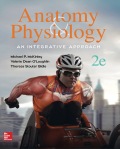
Anatomy & Physiology: An Integrative Approach
2nd Edition
ISBN: 9781259124075
Author: McKinley
Publisher: MCG
expand_more
expand_more
format_list_bulleted
Concept explainers
Question
Chapter 11.9, Problem 28WDYL
Summary Introduction
To determine:
The common actions of each of the compartments of the leg.
Concept introduction:
Muscles are responsible for locomotion and movement of internal organs such as heart by cardiac muscle. There are three types of muscles such as cardiac, skeletal, and non-skeletal muscles that perform specific functions in the body.
Expert Solution & Answer
Want to see the full answer?
Check out a sample textbook solution
Students have asked these similar questions
What is the role of contraction of the leg skeletal muscles?
What makes a person’s leg more or less stiff during running or hopping? What sort of internal (anatomical, physiological, and/or physiological) factors will influence leg stiffness?
What is the value in wearing proper footwear while performing various activities? How can this affect the structure or function of the foot?
Chapter 11 Solutions
Anatomy & Physiology: An Integrative Approach
Ch. 11.1 - What is the difference between the origin and...Ch. 11.1 - Which muscle is strongera pennate muscle or a...Ch. 11.1 - What is the difference between an agonist and a...Ch. 11.2 - What are some words used in muscle names that...Ch. 11.2 - The gluteus maximus muscle gets its name from...Ch. 11.3 - Prob. 6WDYLCh. 11.3 - Prob. 7WDYLCh. 11.3 - Which extrinsic eye muscles abduct the eye (move...Ch. 11.3 - Prob. 9WDYLCh. 11.3 - Prob. 10WDYL
Ch. 11.3 - List the four suprahyoid muscles, and describe a...Ch. 11.3 - Which neck muscles extend the neck? Which neck...Ch. 11.4 - Which muscles form the erector spinae, and what...Ch. 11.5 - Prob. 14WDYLCh. 11.5 - How is the diaphragm involved in respiration?Ch. 11.6 - What are the main actions of the abdominal...Ch. 11.7 - Prob. 17WDYLCh. 11.8 - Prob. 18WDYLCh. 11.8 - Prob. 19WDYLCh. 11.8 - Identify the rotator cuff muscles, and describe...Ch. 11.8 - What are the muscles in the anterior compartment...Ch. 11.8 - Prob. 22WDYLCh. 11.8 - Prob. 23WDYLCh. 11.8 - What muscles in the posterior compartment move the...Ch. 11.8 - Prob. 25WDYLCh. 11.9 - Prob. 26WDYLCh. 11.9 - Prob. 27WDYLCh. 11.9 - Prob. 28WDYLCh. 11.9 - Prob. 29WDYLCh. 11 - _____ 1. Which statement is true about an agonist?...Ch. 11 - Prob. 2DYKBCh. 11 - _____ 3. When this large muscle contracts, the...Ch. 11 - Prob. 4DYKBCh. 11 - _____ 5. Each of these muscles can flex the...Ch. 11 - _____ 6. The dorsal interossei muscles in the hand...Ch. 11 - Prob. 7DYKBCh. 11 - Prob. 8DYKBCh. 11 - Prob. 9DYKBCh. 11 - Prob. 10DYKBCh. 11 - Prob. 11DYKBCh. 11 - Which muscles of facial expression do you use to...Ch. 11 - Distinguish between suprahyoid and infrahyoid...Ch. 11 - What is the effect of contracting the abdominal...Ch. 11 - What movements are possible at the glenohumeral...Ch. 11 - Identify the compartments of the arm (brachium),...Ch. 11 - Prob. 17DYKBCh. 11 - Prob. 18DYKBCh. 11 - What leg muscles allow a ballet dancer to rise up...Ch. 11 - Which muscles are responsible for foot inversion?Ch. 11 - Prob. 1CALCh. 11 - Prob. 2CALCh. 11 - Prob. 3CALCh. 11 - Prob. 4CALCh. 11 - Prob. 5CALCh. 11 - Prob. 1CSLCh. 11 - While training on the balance beam, Pat slipped...Ch. 11 - Prob. 3CSLCh. 11 - Why is it more difficult for Eric to lift a heavy...
Knowledge Booster
Learn more about
Need a deep-dive on the concept behind this application? Look no further. Learn more about this topic, biology and related others by exploring similar questions and additional content below.Similar questions
- What is the function of the lumbar curvature and how may low back pain be related to poor abdominal muscle tone?arrow_forwardWatch this video (http://openstaxcollege.org/l/kneejoint1) to learn more about the anatomy of the kneejoint, including bones, joints, muscles, nerves, and bloodvessels. Which ligament of the knee keeps the tibia fromsliding too far forward in relation to the femur and whichligament keeps the tibia from sliding too far backward?arrow_forwardDescribe the functions of the pelvic floor muscles.arrow_forward
- What are the functions of each of the intracapsular ligaments of the knee joint?arrow_forwardDescribe and identify on which segment of the legs/limbs would you expect the ambulatorial, fossorial, grasping, natatorial and raptorial type of legs/limbs be located?arrow_forwardWhich of these is not in the anterior compartment of the thigh? a. semimembranosus b. rectus femoris c. vastus intermedius d. vastus lateralis e. sartoriusarrow_forward
- what is the function of pectoralis major and pectoralis minor. Also what is the function of rectus abdomius and transverse abdominus?arrow_forward.Explain how the rectus femoris can be part of the quadriceps femoris group that mainly extends the knee but also flexes the thigh?arrow_forwardDistinguish between the lower limb and the leg.arrow_forward
arrow_back_ios
SEE MORE QUESTIONS
arrow_forward_ios
Recommended textbooks for you
 Concepts of BiologyBiologyISBN:9781938168116Author:Samantha Fowler, Rebecca Roush, James WisePublisher:OpenStax College
Concepts of BiologyBiologyISBN:9781938168116Author:Samantha Fowler, Rebecca Roush, James WisePublisher:OpenStax College

Concepts of Biology
Biology
ISBN:9781938168116
Author:Samantha Fowler, Rebecca Roush, James Wise
Publisher:OpenStax College
Chapter 7 - Human Movement Science; Author: Dr. Jeff Williams;https://www.youtube.com/watch?v=LlqElkn4PA4;License: Standard youtube license